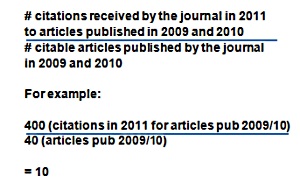Impact factors
Once you have decided on some possible titles you may wish to check the quality of those journals against other journals in the same subject area. Impact factors are a useful way to do this.
What is an impact factor?
An impact factor is a way of measuring the relative quality of a journal within a particular field:
Journal impact factor is the average number of times that articles published in a specific journal in the two previous years (e.g. 1998-99) were cited in a particular year (i.e. 2000) (Tree, v.14, no.10 Oct. 1999, p, 382)
The calculation is determined as follows:
As with all statistical types of analysis, journal impact factor rankings also need to be evaluated and not just taken as fact. For example, review journals often have very high impact factors because review articles are generally cited more frequently than research articles. Of course, a review journal may not be the ideal journal in which to publish your work. Some disciplines may work on a five year impact factor but this would normally be specified.
Why are impact factors important?
Impact factors provide an approximation of the prestige of journals. They are used in conjunction with other considerations such as peer review and scope and they may vary between disciplines. Journals must be viewed in the context of their specific field.
You may find impact factors by searching the database Journal Citation Reports.
